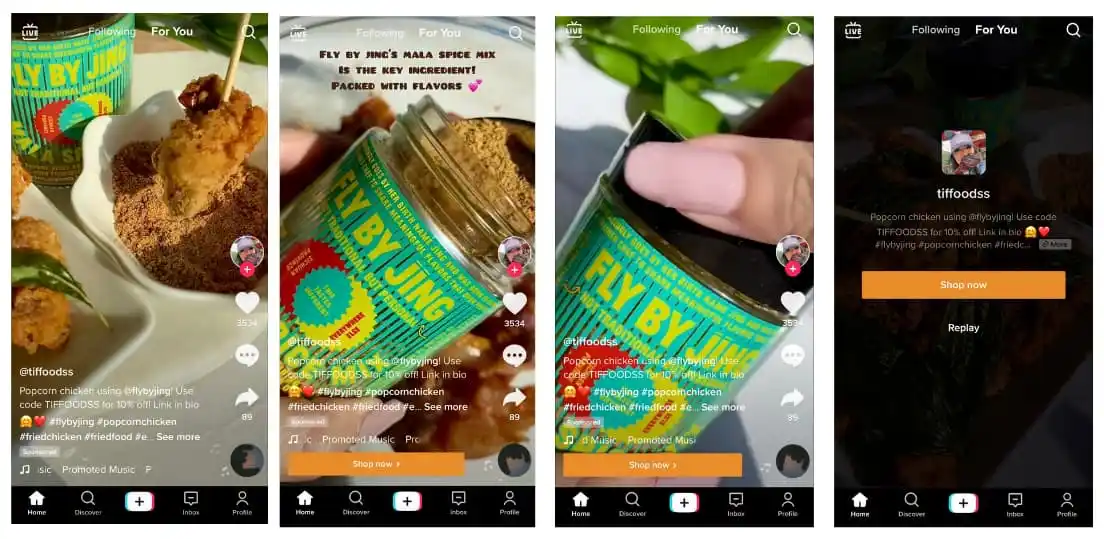
I see short-form videos everywhere nowadays. And now, as platforms like TikTok, Instagram Reels, YouTube Shorts, Google, LinkedIn, and Pinterest expand their short-form offerings, brands are continuing to take notice.
In the 2024 HubSpot State of Marketing Report, we found that short-form video is the number one format marketers are using and will see the most growth in 2024.
What’s more? Short-form video has the highest ROI of any social media marketing strategy in 2024.
So, how can you join in on the short-form video action to grow your business? And what are some trends to look for in the next year? In this post I’ll share advice from video marketing experts. Here’s what we’ll cover:
What are short-form videos?
The general consensus among marketers is that any video under 60 seconds is considered short-form, with the optimal length between 31 and 60 seconds.
Brandon Sanders, former digital marketer for HubSpot Academy, highlights that what’s considered short-form can also depend on the platform.
With the rise of platforms like TikTok, Reels, and YouTube Shorts, “short-form video is actually getting shorter and lending itself more to 60-second to two-minute videos,” Sanders said.
Before YouTube Shorts, the 10-minute mark was the “sweet spot because content on YouTube tends to be more comprehensive,” but now with Shorts, you are limited to 60 seconds if you want to be featured in that media.
According to our 2024 State of Marketing Report, 36% of video marketers believe that the optimal length for a marketing video is between one and three minutes, 27% say the optimal length is four to six minutes, and 15% say it’s seven to nine.
So, shorter videos really are the star in 2024 marketing trends.
How do short-form videos fit into your content strategy?
HubSpot’s Marketing Trends Report for 2024 found that short-form video is the top leveraged media format in marketers’ content strategies.
We already know video content is increasingly becoming an important part of every brand’s content marketing strategy.
However, when we look at short-form video specifically, the data (gathered from the HubSpot 2024 State of Marketing) speak for themselves:
- Short-form ranks #1 for return on investment ROI.
- 56% of marketers using TikTok will increase their investment next year.
- 25% of marketers plan to invest more in short-form video in 2024.
- 30% of marketers who aren’t currently using short-form videos plan to start in 2024.
Sanders says short-form videos give creators an innovative way to showcase their content.
“The growth of social media is causing the human attention span to become shorter and shorter,” he said. “So, leveraging the power of short-form content will give you a leg up on your competition and help engage your audience.”
Aside from length, one thing that sets short-form videos apart is the trend culture.
TikTok, for instance, is run by viral songs, trends and challenges, and topics of interest. So, to get on the “For You” page on TikTok — which is equal to the “Explore” page on Instagram — brands must join in on the fun.
Apps like TikTok have also been influenced by AI. Users generate AI-narrated voices or use AI to ask questions and generate images. TikTok also has tools like its Creative Assistant available for its users so they can benefit from AI.
As with any new trend or platform, former HubSpot Senior Content Strategist Amanda Zantal-Wiener says you should always consider your audience first:
“It all goes back to a very old question: Which channels are your audiences using and for what? And therefore, for which channels does it make the most sense for your business to create this short-form content?”
This means that while short-form video is often known for its entertainment value, you can adapt it to align with your brand.
You should also do as much prep work as you can before a video shoot. Video marketer Tanner Francom describes this as “gathering inspiration.”
He says “helps to craft shots in both pre-production and on set. Before putting together a shot list, we gather an inspiration board full of shots that we want to replicate or have certain aspects we’d like to include in the video.”
If you consider your audience and sufficiently prep for your short-form videos, there’s no trend you can’t tackle in 2024.
Short-Form Video Trends to Look Out For
1. Brand Challenges
When short-form videos first gained popularity, it was through viral content based on dances, songs, and sounds.
Today, brands can make their own sounds, filters, and challenges go viral.
According to our social media trends report, 20% of marketers surveyed leveraged branded challenges, and 42% said they performed better than expected.
In addition, marketers rank them among the most effective social media trends of 2024.
Short-Form Video Example: Colgate
@zahra look how beautiful my momma is :’) #MakeMomSmile @colgate_us #ColgatePartner ♬ Children Folk Acoustic – BDKSonic
To celebrate Mother’s Day, Colgate launched the #MakeMomSmile challenge, which encourages users all around the world to share videos in which they did something special for their mothers.
It’s also a great play on words, as Colgate is all about providing beautiful smiles to its customers.
What I Like: Brand challenges, like Colgate’s, should be fun and accessible to all.
In my experience, it’s really important you announce winners in a timely fashion and feature the winning videos on your page so those who participated don’t forget about the campaign.
2. Influencer Ads
Brands have been leveraging influencer marketing for years; that’s nothing new. However, we’re now seeing more brands use them in short-form video content.
Influencer marketing is here to stay. 88% of companies using influencer marketing say it’s effective, and 55% of those surveyed said, “My company will invest more in influencer marketing in 2024.”
For instance, popular TikTok influencer TiffFoods starred in an ad for food brand Fly by Jing to promote its product.
Short-Form Video Example: Fly by Jing

With short-form content lending itself well to native advertising, brands can create videos that are more likely to generate conversions.
Pro Tip: Choosing which influencer to represent your product isn’t easy. You want someone who stands for the same values as your business. Check out this blog on how to choose the best influencer for your brand.
3. Product Teasers
Think about the average commercial you see: It’s usually anywhere between six seconds to 60 seconds. This also happens to be the average length of a short-form video.
Because of this, brands can leverage short-form video platforms to promote their products organically.
It can be incredibly effective because it doesn’t require a large budget, it has the potential to go viral, and it builds anticipation around your brand.
Short-Form Video Example: Crumbl Cookies
Crumbl cookies is notorious for teasing new products and then revealing them as the cookies of the week. They’ve even branched out into pies and cakes recently.
Product teasers are great because they create suspense by getting users to be even more invested in the launch as they wonder what the reveal is.
Pro Tip: A rotating product reveals with consistent teasers is a great marketing strategy for building anticipation. Whenever you have a new product to launch or a short-lived/seasonal product, be sure to hint at what’s coming at least a week before the launch.
As video marketer George Haddad puts it: “Consistency matters. But high-quality consistency is crucial.”
4. More User-Generated Content (UGC)
Consumers generally love UGC. In fact, in a recent HubSpot survey of 500+ marketers who sell content via social shopping features, 92% said user-generated content increases their brand awareness.
According to HubSpot Blog research, UGC also offers great ROI, with 40% of marketers surveyed ranking it as a high-ROI format on social media.
Our research also suggests it’s popular with Gen Z, which is the biggest demographic on TikTok.
Why is UGC a winning strategy? Well, without using up too many resources, brands can easily publish videos that evoke emotion, and feel authentic and relatable.
Short-Form Video Example: Chipotle
@chipotle Out of this world delivery ha @cheekyboyos #chipotle #burrito #space #fyp ♬ original sound Chipotle
This video is a great example of how you can leverage user-generated content in your strategy. In this instance, Chipotle collaborated with these content producers to create a fun, viral-worthy video.
One of Chipotle’s target audiences might be young college students looking for inexpensive meals.
This video features two creators who reflect the audience they may want to attract. Brands should keep this in mind when considering UGC and ask, “Will my audience relate to this?” If the answer is yes, move forward.
What I Like: Not all UGC campaigns are equal, and it can be hard to get participation. Check out this blog for more examples of UGC campaigns that work to inspire your UGC strategy.
5. More Behind-the-Brand Videos
Consumers seek out authenticity and transparency in brands. With short-form video, you only have a few seconds to connect with your audience.
So, how do you do that? Well, there’s no exact science to it, but consumers tend to feel more connected to brands that show the people behind the brand.
In one Sprout Social study, 70% of consumers said they felt more connected to brands whose CEO is active on social media platforms.
So, going into 2024, brands should pull back the curtain and engage with their audiences on a more personal level. Not sure how to personalize your content in a way that suits your audience? I recommend A/B testing videos to see which ones perform better, and so does video content marketer Ernie Santeralli:
“What do dynamic duos such as peanut butter and jelly have in common with A/B testing and personalization? They’re better together. And in the case of A/B testing and personalization, the benefits to the online experience (and results) become exponential when you combine them.”
Short-Form Video Example: Formula One
Is there any sport that’s giving viewers as much behind-the-scenes action as Formula One? I don’t think so.
With their Netflix special and thriving social media accounts (like YouTube), Formula One uses short-form video content to engage with viewers on a daily basis.
Viewers feel extra invested because they feel like they know each driver and each car brand intimately, giving the races higher stakes.
Pro Tip: Brainstorm with your marketing team on how you can pull back the curtain on your company and let customers know more about what makes your brand tick.
This might look like an interview with your CEO or a video explaining the history of your company. Let your viewers see why you’re passionate about what you do and what you have in plan for the future.
6. More Explainer or Educational Videos
In 2024, brands will likely focus on educational content in their short-form videos — think how-to’s, DIYs, and explainer videos.
A 2024 Wyzowl report found that viewers want to see more of this video style from brands.
Wondering where we currently stand? 32% of marketers surveyed in our social media trends report say they currently leverage educational content and 57% of those who do say it’s one of the most effective content types.
Educational videos are great added-value content because they help audiences in their day-to-day lives. Brands that make education a priority in their marketing strategy can improve lead generation and build stronger brand loyalty.
Similarly, explainer videos target users who are at the decision-making stage of the buyer’s journey and if done right, they can turn decision-makers into customers.
It’s a win-win situation: Brands get to address their audience’s pain points and offer solutions, which is (surprise!) them. Not sure what I mean? See the example below.
Short-Form Video Example: Soy Yo Candle
Soy Yo Candle used the formula mentioned above to create this short-form video. Presumably, one of the biggest struggles of owning candles is making them last.
In just a few seconds, the brand presented a problem, offered a solution, and promoted its product. It can be as simple as that.
Another highlight in this video is that it caters to viewers who may be discovering the brand and those who already know it. Because of the value it offers, the brand can reach a broader audience organically.
Not sure how to sell an educational video? Short-form video marketer Charis Maimaris says you should create short and engaging content.
His top tips for engaging content include “using an emotional or intriguing hook, keeping it short and to the point, using strong visuals and sound effects, and telling a story.”
Pro Tip: Rehash and recycle your content. If you’ve written an informational piece of content in the last year, use this to create an educational video for your subscribers and customers.
There’s no reason to reinvent the wheel when you’ve already spent time perfecting content that can be reused and reinvented.
Takeaways for Video Marketers
Social Media Content Manager Kelsi Yamada says using short-form video is a low-commitment and engaging way to connect with your audience.
“You can get a good laugh or learn something new in a minute or less on TikTok or Reels,” said Yamada.
“On the flip side, it’s also relatively easy to create, which means there are more people who can share their humor or points of view. Because of this, brands should figure out what their unique point of view is, and how they can stand out in the noise.”
The desire to be on-trend is always tempting. But, Yamada stresses that brands should be selective about which trends they partake in.
“Not every viral TikTok sound or meme format will align with your content strategy or brand, so don’t force it,” she said.
“Focus on catering to your niche and staying authentic first. Don’t be afraid to make something completely from scratch – trends have to start somewhere!”
With this in mind, it’s all about finding the balance between what’s trending and what’s on-brand for your business. If you want to explore more about video marketing more broadly, check out HubSpot Academy’s courses on Video Marketing and Developing a Video Marketing Strategy.
Best Platforms for Short-Form Videos
- TikTok
- Instagram Reels
- YouTube Shorts
- Triller
- Hippo Video
- Magisto
- Lately.ai
- Wistia
1. TikTok
With at least 47% of its users between 10 and 29 years old, TikTok is definitely the platform for the Millennial and Gen Z population.
The TikTok homepage features a timeline of videos separated into two tabs.
The “Following” tab has videos posted by the user’s followers, and the algorithm-driven “For You” page is based on user behavior (what they like, comment on, scroll past, etc.)
The “Discover” tab on TikTok highlights trending topics and hashtags, and in my experience this is a great resource for marketers to generate new content ideas.
B2B marketers have been wary of using the platform, but it could be because success on the platform relies on emotional appeal. Yet, that emotional appeal may be exactly what they need.
According to a VML insight report, emotional B2B marketing can be seen as “a radical new approach to communicating with business customers.”
Still not quite convinced TikTok is a viable marketing platform for your business?
Check out this video explanation of how TikTok has grown into one of the most go-to platforms for short-form content today.
Now, it may be time to start practicing those dance moves.
2. Reels
Some call it TikTok 2.0, but Instagram Reels is proving to be its own beast.
The Reels tab on Instagram is a scrollable video timeline, similar to what users see on their Explore page. From this page, users can click on the music the account used to see what other Reels feature that sound.
With over 1 billion active monthly users, Instagram already had consumers’ attention. When they launched Reels back in August of 2020, it became another marketing tool for brands and a worthy opponent for TikTok.
Instagram caters to a broader age demographic than TikTok, and considering their other marketing features, Reels is another way for brands to expand their reach in a minute or less.
3. YouTube Shorts
YouTube Shorts is YouTube’s venture to mobilize short-form videos on its long-form video platform. YouTube first started testing it back in September 2020, and now has over 2.3 billion monthly active users.
When using YouTube‘s mobile app, you’ll see that Shorts now has a dedicated tab on the platform. Users can create Shorts up to 60 seconds and, similarly to other short-form video platforms, can edit the videos directly within the app.
. Triller
Triller is Tiktok’s musical theater friend (or rival) — the one who bursts into song anytime, anywhere, without cause or notice.
Triller’s homepage looks similar to other short-form video platforms. However, They have made music a prominent feature on the app by making top and trending music the main tab.
The platform is popular among musical artists and allows users to edit 60-second videos within the app.
This includes music, filters, effects, and transitions. Triller first grew in popularity when there was some uncertainty surrounding a TikTok ban in the United States, but has become a worthy competitor.
With music playing a key role in the app, marketers could use music as a storytelling element in their videos.
For instance, a few years back the song “You Got It” by Vedo — a song about unlocking your potential — made its rounds on Triller.
A recruiting firm could’ve used that sound to create a short video targeting job seekers. The song would also work great as a backdrop for a business coaching company advertising its services.
5. Hippo Video
If you want to take short-form video content beyond social media, there’s Hippo Video.
The video marketing platform gives brands a one-stop-shop to produce, distribute, and analyze their video content. Users can also embed forms, CTAs, and annotations within the video, making conversions easier.
For example, let’s say a SaaS company is launching a new product, and the marketing team is using Hippo Video for the email campaign.
On launch day, they can send a product teaser video to current customers and include a “Schedule a Demo” CTA, leading users to a meeting scheduling page.
During the campaign, the team can track key metrics like total plays and average watch rate — taking video analytics to another level.
6. Magisto by Vimeo
Vimeo recently acquired Magisto, a video editing software that makes video marketing easy through AI.
To get started, first upload your videos. The software will then analyze the videos and put them together based on the video editing style you’re looking for.
They have over ten editing styles ranging from real estate and fitness to Facebook and YouTube ads.
Once you select the style you’re looking for and the video is complete, you can distribute it on social media platforms and track the analytics.
This platform is ideal for brands that don’t want to spend too much time or too many resources on video marketing. This app does it so you don’t have to.
7. Lately.ai
If your brand is short on time and resources but wants to leverage short-form video, consider Lately.ai.
This software, powered by AI, takes long-form audio, video, and text and atomizes it into snackable posts for social media. How does it know what will work? That’s where the AI comes in.
It looks at what content your audience is most likely to respond to based on historical data and creates from there. It’s a great tool for brands who are dipping their toes into short-form content and want to build from their current library.
8. Wistia
Wistia is a leader in the video hosting industry, helping more than 300,000 businesses manage their video content and grow their audience.
When using this platform, you can build a customizable video player that matches your brand, use lead generation tools, and track your videos’ performance to gain insights.
You can also create custom ad audiences for search and social to ensure your content reaches the right audience and use integrations to sync all your tools.
There are hundreds of ways to incorporate short-form videos into your marketing strategy. But no matter which trends come and go, it will always come back to your audience.
Try a few approaches, and listen to where the data tells you to go next.







